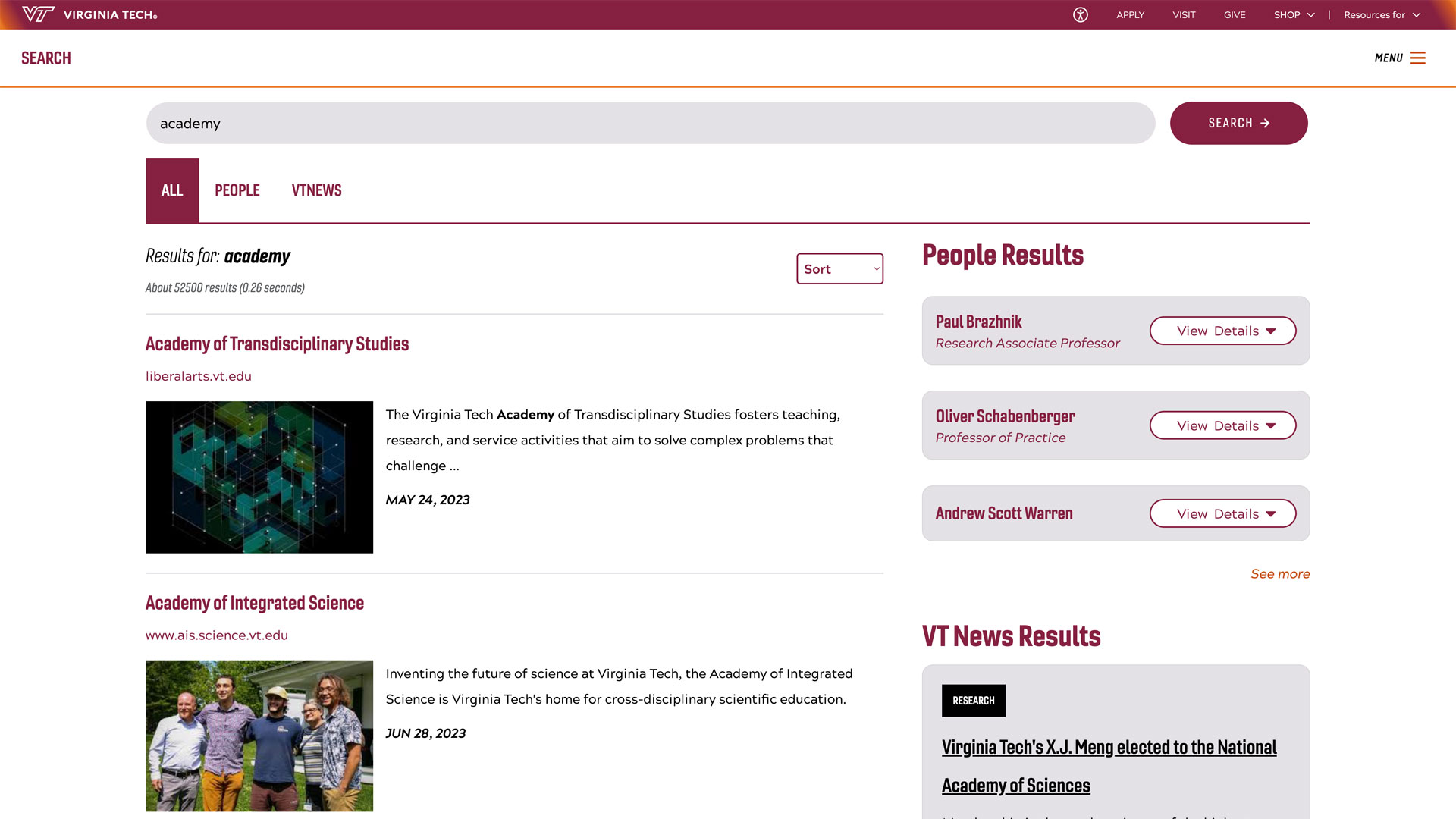National Academy of Inventors names seven senior members
The Virginia Tech faculty were among 162 emerging inventors from across the nation to make up the academy's 2025 class.

Seven Virginia Tech faculty members have been named senior members of the National Academy of Inventors.
Alaa Algargoosh, Anna Duraj-Thatte, Jonas Hauptman, Brook Kennedy, Guoliang "Greg" Liu, Roop Mahajan, and Danfeng "Daphne" Yao were among 162 emerging inventors from across the nation to make up the 2025 class. According to a media release from the academy, this is the largest class to date and collectively represents more than 1,200 U.S. patents.
“This year’s class comes from a multitude of impressive fields and research backgrounds from across the world,” Paul R. Sanberg, the academy’s president, said in the release. “We applaud their pursuit of commercialization to ensure their groundbreaking technologies can make a difference by tackling the world’s most pressing issues, improving quality of life across society, and advancing the economy.”
Founded in 2010, the National Academy of Inventors is made up of U.S. and international universities and government and nonprofit research institutes, with over 4,600 individual inventor members and fellows spanning more than 260 institutions worldwide.
The newly elected Virginia Tech faculty join six colleagues as senior members of the academy and nine who have risen to the level of fellow in the academy, including President Tim Sands.
More on Virginia Tech’s newly elected senior members:
Alaa Algargoosh, assistant professor of architecture
Invention highlights: Algargoosh’s work bridges design and technology while focusing on acoustics, her work investigates the links between the physical, perceptual, and social aspects that shape the acoustic experience. This includes:
Sound diffusers inspired by the Cymatic phenomenon of visualizing sound to control acoustic defects, resulting in more evenly distributed sound
A novel method to analyze resonance in spaces with complex geometric features, given its role in enhancing the acoustic experience
Two patents issued
Why it matters: Algargoosh’s diffusers address environmental challenges as a sustainable acoustic technology that require significantly fewer units than standard panels to achieve optimal sound control. Tested in classrooms, they reduce the need for sound amplification, demonstrating practical benefits for learning environments with limited resources. Her research also addresses social issues, such as the impact of acoustic environments on health in at-risk communities and includes auditory accessibility for neurodivergent individuals. Currently, her work extends to developing acoustic metamaterials and a generative artificial intelligence tool for reconstructing three dimensional environments from sound.
Anna Duraj-Thatte, assistant professor of biological systems engineering
Invention highlights: Duraj-Thatte’s work focuses on the development of engineered living materials that provide innovative and sustainable solutions for producing functional materials that are smart and biodegradable. These include:
Water-processable and biodegradable bioplastics, whose mechanical properties are comparable to petrochemical plastics
3D-printable living inks produced from engineered microbes for drug delivery, the sequestration of toxins, and building structural materials
Five patents issued and two more pending
Why it matters: Her research has led to a new method for treating inflammatory bowel diseases and the creation of a start-up company developing probiotics to that end. Her work will contribute toward sustainable production of functional materials that can potentially replace some synthetic polymers and advance the biomanufacturing and bioeconomy goals of the U.S.
Guoliang "Greg" Liu, professor of chemistry
Invention highlights: Liu has invented a series of new technologies including:
Using block copolymers — a self-assembly technique for the large-area patterning of extremely small surfaces — to template the fabrication of nanoscale features on silicon wafers for semiconductor uses
Improving the synthesis of high-performance engineering polymers such as polyetherimides — a high-performance, amorphous thermoplastics
Fabricated the world’s thinnest electrostatic speaker membranes made of single layer graphene and polymer
Developing new ways to recycle and upcycle plastic waste into high-value chemicals and materials
Eight issued patents, eight pending, and three patents via the World Intellectual Property Organization’s Patent Cooperation Treaty
Why it matters: Liu’s work has been applied to the semiconductor industry and the data storage industry as well as a wide range of applications in electronics, airspace, and aerospace. His technology for next-generation speakers offers substantial savings in energy and his work with plastic waste recycling and upcycling has the potential to create substantial economic and environmental benefits.
Jonas Hauptman, associate professor of industrial design
Invention highlights: Hauptman’s work focuses on bio-inspired design and sustainable materials. His efforts include:
Serving as the lead developer of MassBu, a system that utilizes lightly modified bamboo culms to create laminated structural panels and beams and enhances bamboo’s structural capabilities and versatility in construction
Being co-inventor of Seeyond, a self-structuring architectural product system that allows designers to create freeform interior structures using origami-inspired, foldable blocks
Research guided by an interest in materiality and form, exploring their interplay through novel tools, processes, and design methodologies.
One patent issued and one more pending
Why it matters: Hauptman’s work addresses critical challenges in the construction industry, such as resource scarcity and environmental sustainability, particularly in tropical and arid regions where bamboo is abundant and housing insecurity is high. It not only promotes eco-friendly building practices but also provides elegant solutions for affordable housing.
Brook Kennedy, associate professor of industrial design
Invention highlights: Kennedy is known for his contributions to industrial design and sustainable design research. This work includes:
Fog water harvesting technology that positions him as a leading expert in the field
An article in the peer-reviewed scientific journal, Advanced Functional Materials, that establishes a vision for the future impact of these technologies, especially those suffering globally from acute water scarcity
21 U.S. patents and two international patents
Why it matters: Kennedy has significantly impacted both the academic research community and industry through his innovative designs, research, mentoring, and outreach efforts. His contributions to the fields of human-centered design and sustainability have helped bridge the gap between contemporary design practices and economical sustainable development, while improving the lives of users including some of the most vulnerable populations. Kennedy's patents across technology and consumer product sectors have also earned prestigious international design awards from Good Design, European Product Design Awards, Consumer Reports, Red Dot, International Design Excellence Awards, and iF.
Roop Mahajan, Lewis A. Hester Professor in the Department of Mechanical Engineering and director of strategic research and innovation for Virginia Tech India
Invention highlights: Mahajan’s impact spans fundamental research, industrial innovation, and education, which is highlighted by his recent work with carbonaceous — made of carbon atoms — nanomaterials. The breakthroughs include:
The creation of a cost-effective, environmentally friendly one-pot process for producing graphene oxide (GO) and reduced graphene oxide (rGO) from anthracite coal, Coal-GO and Coal-rGO, respectively
The development of Coal-rGO as a safer alternative to the harmful binding material 6PPD used in rubber tires, with funding from the National Science Foundation/University Cooperative Research Center’s Center for Tire Research
Engineering high-performance polymer composites with Coal-GO and Coal-rGO, enhancing mechanical strength and thermal conductivity for applications in automotive, aerospace, and electronics industries
More than 250 peer-reviewed publications
Six patents issued and two more pending
Why it matters: Mahajan’s work has laid the foundation to make coal-derived graphene accessible to a broader scientific community and at a time when China dominates graphite production. His innovations have garnered widespread media attention and made substantial contributions to transport phenomena, artificial neural networks, and humanistic engineering.
Danfeng "Daphne" Yao, professor of computer science and the Elizabeth and James E. Turner Jr. Faculty Fellow
Invention highlights: Yao has pioneered multiple high-precision anomaly detections for complex software and systems, aiming to advance the deployability and security guarantees of enterprise cyber defenses. This includes:
Invented methodologies for achieving high-precision vulnerability screenings
Developed the open-source CryptoGuard, which was the first deployment-quality tool for detecting cryptographic and security misuse in Java
Conducted the first measurement on payment card industry data security standards and identified serious deficiencies in compliance enforcement
Invented patented systems to proactively secure enterprise networks
Pioneered influential privacy-preserving detection solutions for cloud
Three patents issued and two more pending
Why it matters: Yao’s cybersecurity measurement methodology is innovative and inspired a new line of compliance research. Her high-precision inventions enabled real-world adoption and advanced the cybersecurity industry. Her work has deeply impacted commercial security products, including mobile device system design, causal tracking, and cloud security services, all contributing to data protection. Additionally, her data breach prevention work helps protect billions of card holders, as payment card industry data security standards are a world-wide regulation applicable to all systems that process payment data.




